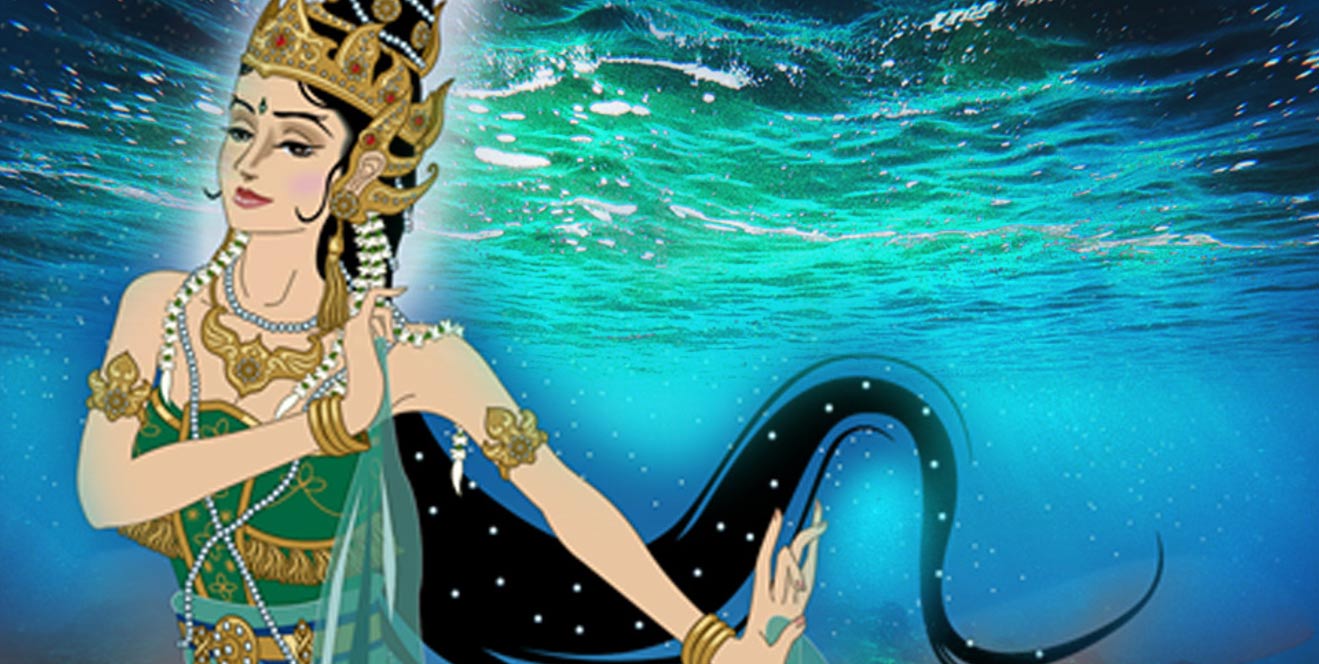
The Dangerous and Powerful Guardian Spirit Queen of the South Seas, Kanjeng Ratu Kidul
Kanjeng Ratu Kidul is a well-known figure in Javanese mythology who is still venerated by the Javanese today as the spirit queen of the Indian Ocean. Living in her palace on the bottom of the ocean off the south coast of Central Java, she rules the ocean, the spirits, nymphs, and other beings from the underworld. Her rare excursions ashore are believed to be accompanied by the occurrence of unusual natural phenomena, such as spring tides. As queen of the Southern Ocean, Kanjeng Ratu Kidul (or Nyai Loro Kidul) is held responsible for disappearances and deaths near or in the ocean. Therefore, like burial grounds, the ocean is also regarded as a dwelling place for the spirits of the dead, especially of people who die unnatural deaths by drowning.
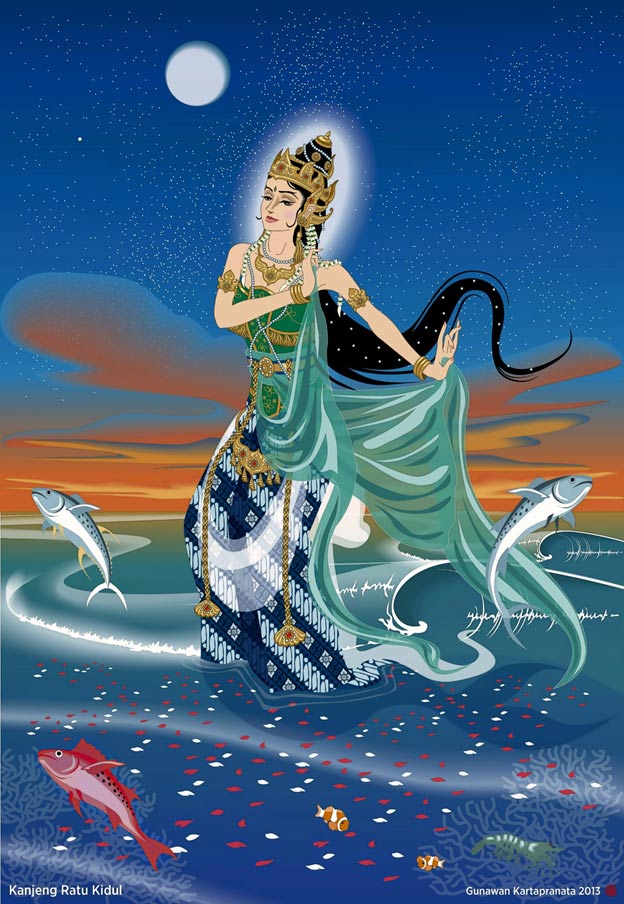
Kanjeng Ratu Kidul, the Queen of the Southern Sea of Java. (CC BY-SA 3.0)
Kanjeng Ratu Kidul is the most prominent of the four guardian spirits of the cardinal directions in Java who receive special veneration even in modern day Surakarta. The four spirits are Kanjeng Ratu Kidul herself who guards the south, Sunan Lawu, the ruler of the spirits on Mt Lawu on the east, Kanjeng Ratu Sekarkedaton, tutelary spirit of Gunung Merapi on the west and Sang Hyang Pramoni, resident of the northern forest Krendawahana.
Although these days the name “Kanjeng Ratu Kidul” (literally means “My Lady Queen of the South”) is the most commonly used, she is also affectionately known as Nyai Roro Kidul. The use of the word “Kanjeng” and “Nyai” in addressing the spirit queen and other Hindu-Buddhist Javanese spirits derived from the traditional habit of the Javanese of considering their relationship with their Hindu-Buddhist gods, deities and ancestral spirits as a relationship to senior but intimate kin. Therefore, they consistently use the kinship terms for their deities and spirits, such as Hyang (exalted ancestor), Eyang (honored grandfather or grandmother), Kiyai (master), or Nyai (madam or mistress), as well as the honorifics for kings or high officials, such as Gusti (Your Highness), Kanjeng (My Lord or My Lady), or Sunan (Your Grace).
The Struggles and Transformation of Kajeng Ratu Kidul
Kanjeng Ratu Kidul is said to have been named Ratna Suwida, the daughter of a ruler of the West Javanese kingdom of Pajajaran although the accounts differ as to who her father was. There are various reasons for her transformation from a princess of the court into the guardian spirit of the Southern Ocean.
The most common explanation is that she was a beautiful young woman who contracted a skin disease due to black magic invoked by a jealous step-mother, forcing her to leave the palace and seek refuge in the forest where she then meditated until she gained special supernatural powers. Other stories say that she declined to marry, refusing one suitor after the next, until finally angering her father who then banished her from the palace, causing her to enter the forest. Still other versions combine elements from these stories and have her contract leprosy on the eve of her marriage, leading her to run away to the forest in disgrace. After meditating in the forest for a long time, she gained great powers and became able to perform miracles such as shape-shifting to cover her skin disease, even turning herself into a man when necessary.
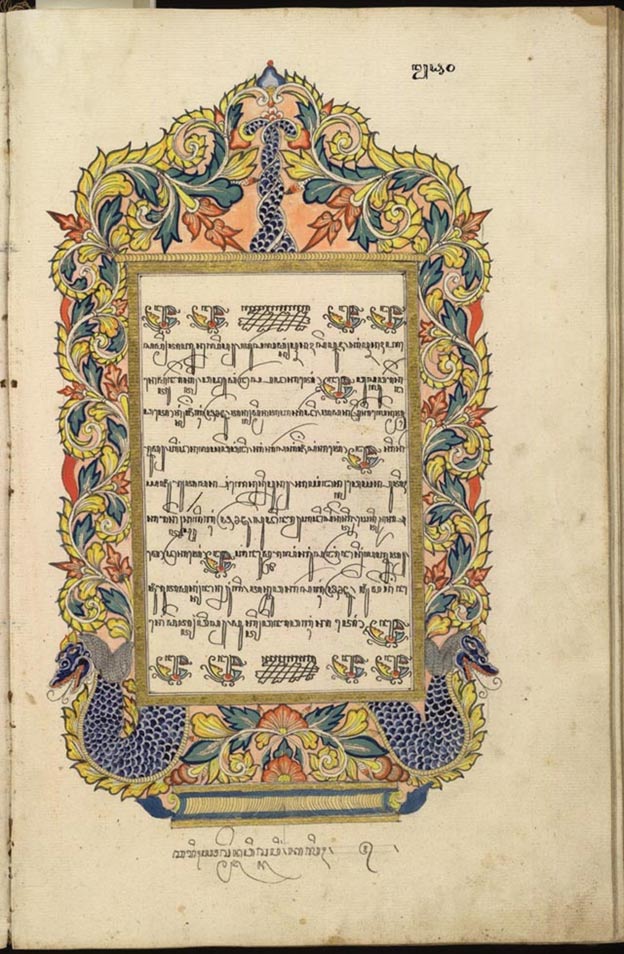
Wadana or frontispiece of Babad Tanah Jawi (History of the Javanese Land) copy from the 19th century. (Public Domain)
According to the nineteenth century chronicle Babad Tanah Jawi (Chronicles of the Land of Java), the orphaned prince of Pajajaran, Raden Joko Suruh, heard a voice of a hermit which ordered him to found a kingdom in East Java. As the hermit stepped into view, Joko Suruh discovered that the hermit was in fact a beautiful young woman, and he fell in love with her. She rejected him, because she was really his kinswoman Ratna Suwida, who was banished long ago and had lived in the forest to meditate ever since. She told him that she would soon leave the forest to the southern coast to take her place as the ruler of the spirit-world and when the descendants of the Gunung Merapi (literally translated as “the Mountain of Fire”) founded a kingdom, she would marry the successive rulers. According to the Kudadu Stele in 1294 CE, Joko Suruh indeed went on to found the kingdom of Majapahit and renamed himself Raden Wijaya.
The chronicle continues that Kinswoman Ratna Suwida soon left the forest and went south until she came to the cliffs overlooking the Southern Ocean. Here, she heard disembodied voices, urging her to enter the waves to regain her former beauty and become the queen of the spirit world. She threw herself into the ocean, was drawn into the depths to a magnificent palace and crowned Queen of the South Seas. It is said she has lived there ever since, ruling over the spirits of Java.
The Power of the Supernatural Queen
Generations later, Kanjeng Ratu Kidul gained considerable prominence owing to her association with Panembahan Senapati, the founder of the kingdom of Mataram, of which the modern day sultanates of Yogyakarta and Surakarta are the inheritors.

Borobudur, one of the monuments constructed during Medang Mataram kKngdom. (CC BY 2.0)
According to the Babad Tanah Jawi, Panembahan Senopati (or Sutawijaya), having received a supernatural sign that he was to become ruler of all Java, went to the shore of the Southern Ocean. After his arrival there, he stood on the shore and prayed with such intensity that he caused a raging storm. Kanjeng Ratu Kidul felt the disaster from her palace at the bottom of the ocean and came to the surface. On the shore, she saw a man absorbed in prayer. Deducing that he was the cause of the disturbances, she asked him to cease. He stopped his prayer and the storms subsided. Recognizing her destined mate, she told him that that he and his descendants would indeed be rulers of Java. She promised him that if there was ever danger, she and her spirit armies would be ready to defend his realm, as long as those ruling Java continued their relationship with her and take her as their divine consort.

Panembahan Senopati caused a raging storm with his prayers. (Flickr/CC BY-ND 2.0)
For the next three days and nights Panembahan Senopati studied the secrets of kingship and the authority over both the human and the spirit realms at the undersea palace of Kanjeng Ratu Kidul. He came back to the surface at Parangkusomo, south of Yogyakarta. As he stepped on the ground, he met Sunan KaliJaga, one of the nine holy men who brought Islam to Java. Sunan KaliJaga admonished him to rely on God and not on magical powers, saying that if he really wished to be ruler he must willingly accept whatever happened to be God’s will. However, Senapati was in reality a royal usurper who never felt himself fully deserving of his throne. He therefore preferred to rely not only on Islam but also on his supernatural relationship with the Queen to bolster and safeguard his position when he founded Mataram II in 1575.
Beautiful Shapeshifter and Winged Snake
Kanjeng Ratu Kidul is believed to divide her time between land and sea. The Javanese believe her demeanor is at times malevolent, and that she can only be soothed by strict observance of complex rituals. Her appearance varies as frequently as her temperament.
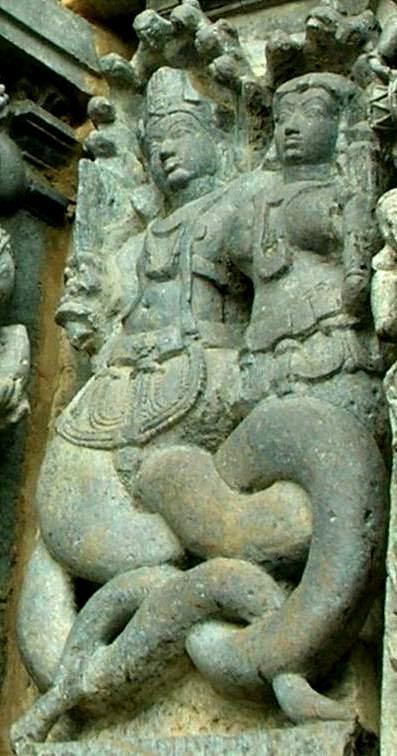
A sculpture of a naga couple in Halebidu, India. (Public Domain)
Apart from her shape-shifting powers, when the moon wanes she becomes an old hag, and when it waxes she appears as a beautiful young woman, having shed her age like a snake sheds its skin. Babad Tanah Jawi characterizes her as “snake-like”. Artistic depictions of Kanjeng Ratu Kidul generally portray her as having the upper body of a beautiful woman and the lower half of a snake which is usually covered by her green gown, her carriage or the wave of the ocean.
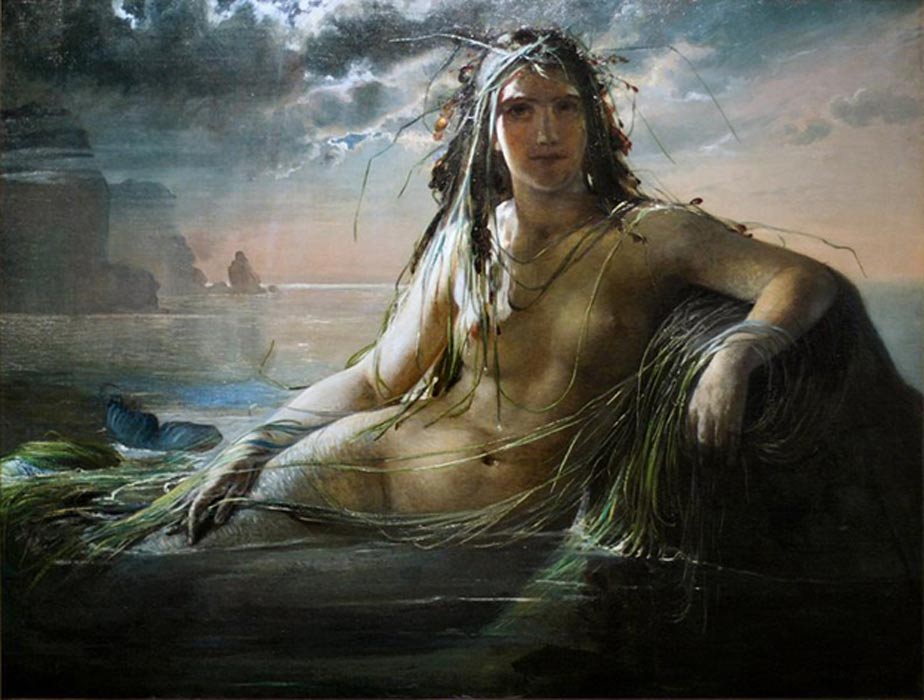
Mermaids in ancient mythologies are women with the lower body of a fish. (CC BY-SA 3.0)
Indeed, snakes are often the physical manifestation of tutelary spirits, perceived to be the protector of the soil and the guardian of its fertility, wealth, and welfare. Most often, like the spirit queen herself, they live in water sources or certain trees. While the snake is not the only form the queen takes, it is a creature that is associated with her by her carriage, usually portrayed as a winged naga (dragon or snake), or the hidden lower half of her body.
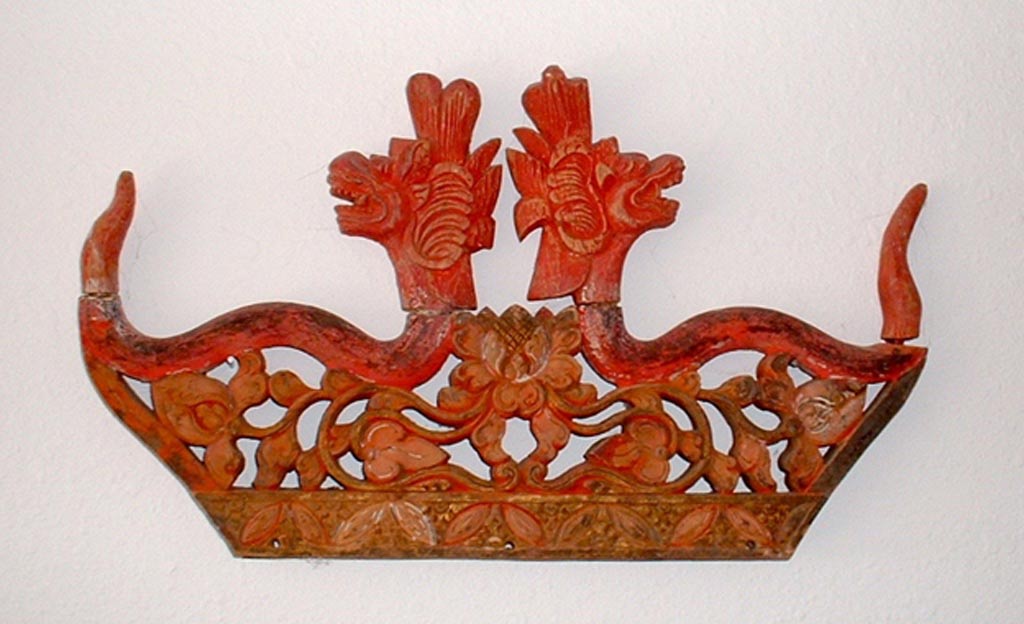
Red Nagas woodcarving from south Java, circa 1930s. (CC BY-SA 3.0)
Possible Mythological Roots
The mythological roots of Kanjeng Ratu Kidul are both much older and go much further afield to South, Southeast, and East Asia. The figure of Kanjeng Ratu Kidul has been influenced by elements from a variety of Indian and Islamic associations with the basic Southeast Asian belief in snake spirits. This belief is also related to the East Asian beliefs in dragons and river spirits, from whom Kanjeng Ratu Kidul inherited her partiality to the color green and her association with rulers.
In the Hindu-Buddhist times of Java (circa 600 – 1500 CE) she was associated with the Hindu goddess Durga and the native Javanese fertility goddess Dewi Sri, both of whom respectively became matched with the malevolent and benevolent sides of her character.
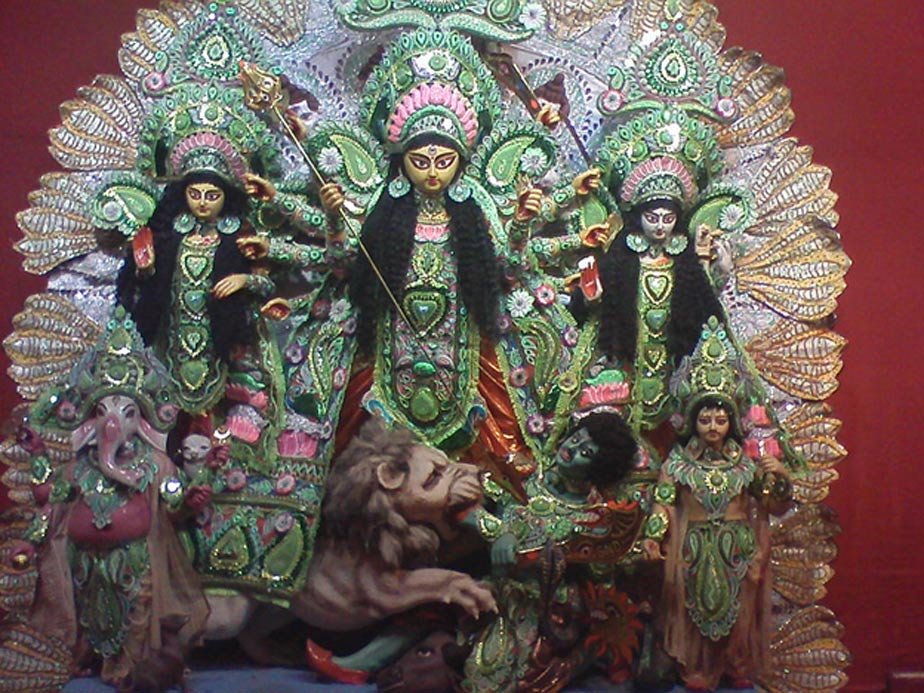
An idol of Durga flanked by her daughters and sons. (CC BY-SA 4.0)
Her relationship with the Javanese royalties also echoes that of the ancient kings of Funan and Cambodia, who were reputed to be descended from an Indian Brahman and the daughter of the serpent king. A thirteenth century report relates how a Cambodian ruler met the serpent goddess who then came to him in human form every night. The king was thereby thought to renew the connection between himself, the sky and the soil, linking his kingdom to the forces of the earth through himself and his descendants.
There are, furthermore, mythic details deriving from India, China, and Southeast Asia that were already long current in Java in the sixteenth century. There is a general tradition, of which the story of the meeting between Senapati and Kanjeng Ratu Kidul is a variant, in which the founders of new states marry princesses who appear from foam floating on the sea.
The Royal Connection
From her first meeting with Panembahan Senopati, Kanjeng Ratu Kidul became intimately connected with the Javanese kingship. The rulers of the two main court cities in Central Java; Yogyakarta and Surakarta, as descendants of Panembahan Senapati, are considered to be the husbands of Ratu Kidul. Both courts regularly present offerings to her at the ocean's shores to commemorate the resurfacing of Panembahan Senopati from her palace. Upon their accession to the throne, the court of Surakarta presented their offerings to Ratu Kidul on a small island in the Southern Ocean near Cilacap where it is said to grow a flower called Wijayakusuma (Epiphyllum oxypetalum, aptly nicknamed “queen of the night”).
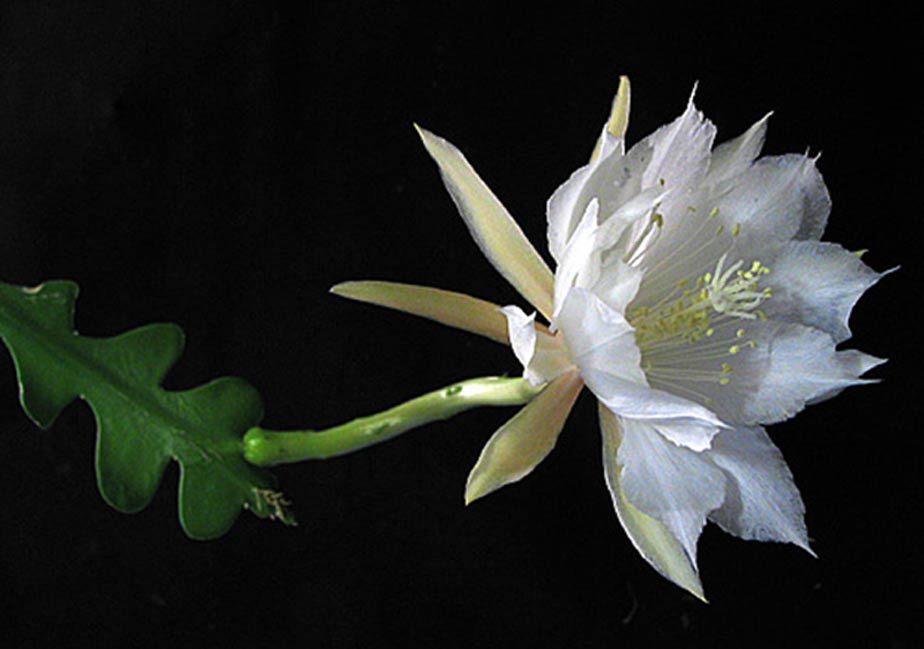
Queen of the Night - Epiphyllum oxypetalum. (CC BY-SA 2.5)
Holiest Sacred Bridal Dance
Also to Kanjeng Ratu Kidul is attributed the origin of the sacred dance Bedhaya Ketawang, the most holy dance of the court of Java, which describes her encounter with Panembahan Senopati. This dance is shown once a year to celebrate the day that the sultan ascended the throne. Nine dancers in classical Javanese bridal dresses dance to invite Kanjeng Ratu Kidul to appear and marry the newly ascended sultan, thus reaffirming the alliance of the ruling house with its divine consort. According to legends, Kanjeng Ratu Kidul appears as a slightly visible tenth figure at the floor of the nine dancers, implying her approval of the newly appointed sultan and her willingness to become his consort.
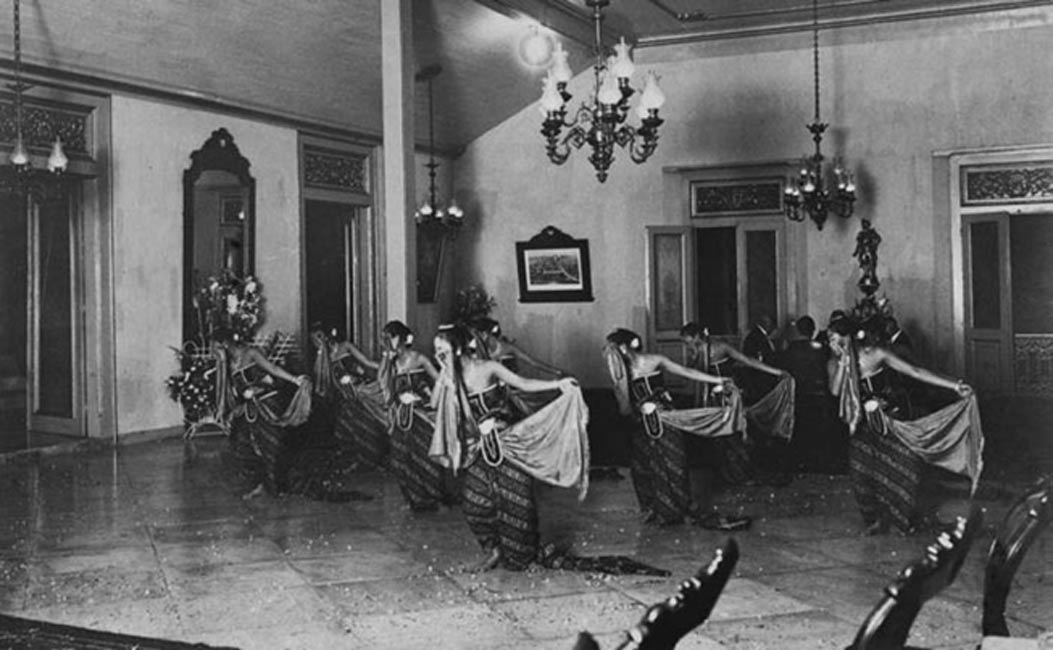
Bedhaya dance at the wedding of a princess of the Mangkunegaran court in 1921. (CC BY-SA 3.0)
When the Kingdom of Mataram was divided into the Hamengku Buwono family of Yogyakarta and the Pakuwubono family of Surakarta in the eighteenth century, the dance was also divided as both courts still claim patronage from Kanjeng Ratu Kidul. Therefore, the court of Yogyakarta renamed the dance Bedhaya Semang, and performed it annually until its last performance in 1914. The court of Surakarta kept the name Bedhaya Ketawang and it is performed annually in the palace of Surakarta to this day.
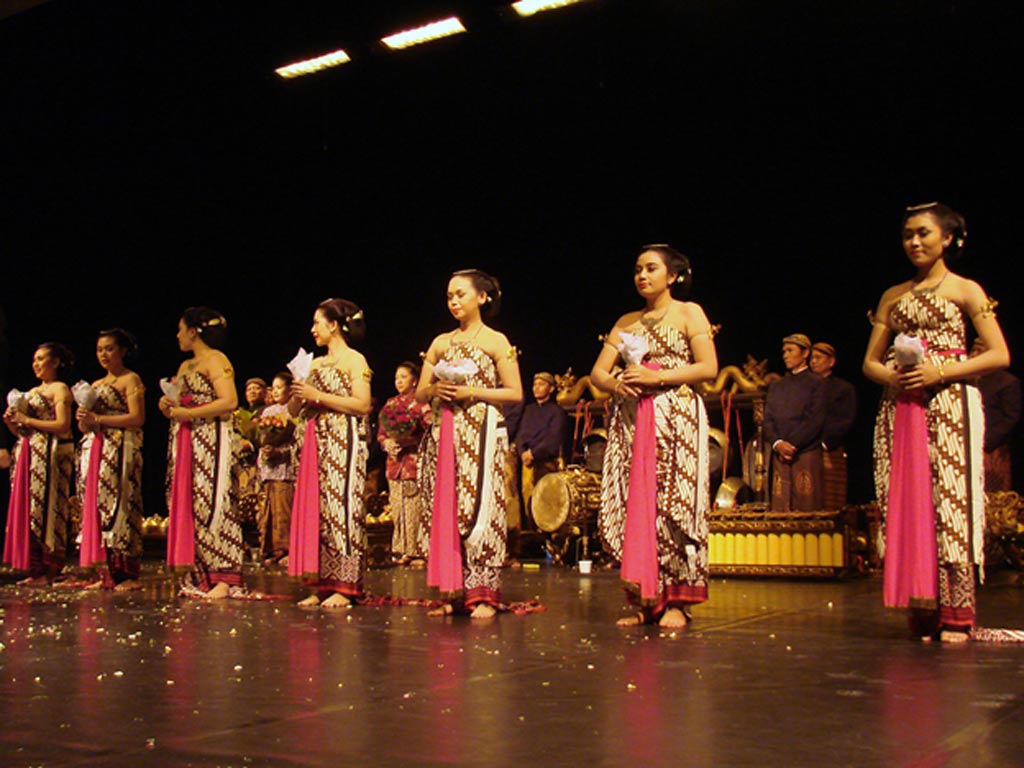
Bedhaya dancers, 2009. (CC BY 2.0)
Kanjen Ratu Kidul’s Patronage and Punishments
Although the Story of Kanjeng Ratu Kidul is claimed by some to have been invented by Sultan Agung of Mataram (1613-1645) in order to legitimize the founding of his state, the relationship between the queen and the rulers of Mataram has continued as a tradition for the kings. She gives their kingdoms legitimacy, as well as patronage and protection. Every sign or “appearance” of Kanjeng Ratu Kidul is therefore of the outmost importance and the courts of Java always seek to renew her patronage whenever it is felt that her relationship with the dynasty has grown distant.
In early 1985, some four hundred years after the fateful meeting between Kanjeng Ratu Kidul and Panembahan Senopati, the central part of the palace of Surakarta caught fire. Witnesses to the fire claimed to see the figure of Kanjeng Ratu Kidul dancing in the flames over the pavilion as it crashed to the ground. The fire and her dance were then interpreted as her final farewell to the Mataram dynasty. However, less than three months after the fire, the reigning sultan Pakubuwono XII again commissioned the performance of Bedhaya Ketawang, reenacting the old alliance between his ancestor and the spirit queen and symbolically remarrying Kanjeng Ratu Kidul.
In 1988, with the death of Yogyakarta’s Sultan Hamengkubuwono IX, followed the rumors of the possibility of the discontinuation of Kanjeng Ratu Kidul’s relationship with the court of Yogyakarta. However, when the late sultan’s son succeeded his father’s throne in 1989, local and national news were filled with stories of Kanjeng Ratu Kidul’s presence in the new sultan’s coronation coach, symbolizing her approval of his installation.
Superstitions relating to Kanjeng Ratu Kidul also persist to this day. One such story is of her partiality to the color green. As green is her favorite color, it is said that she becomes jealous of those who wear this color on her shores. The Javanese avoid wearing green when they go to her beaches and advise tourists to do the same. There are recorded stories about surfers and other people who ventured in her waters wearing green and afterwards were troubled in some form or another. In one story published in “The Jakarta Post” in September 1995, a man who challenged this taboo wore a green t-shirt at a beach on the coast of Cilacap on West Java. The Post reported that the man is plagued by frightening visions, “he can not look backwards now, because all he sees are monsters.”
In 1966, the sultan at the time was expected for the opening ceremony of the Samudra Beach Hotel in west Java. The night before the hotel’s grand opening, it is said he was visited by an old man. The old man told he sultan that he had a dream the previous night in which an old lady dressed in green demanded her offerings. The sultan, knowing the lady to be Kanjeng Ratu Kidul, thanked the man but explained that he would not make an offering since he was attending the hotel opening in his civilian capacity and wanted to separate affairs of state from the mystical duties of the palace. Shortly after the old man left, there was a huge roar at the hotel, and suddenly came a 10-foot- (3-meters-) -high wave from previously calm waters, sweeping away the hotels buffet table and cutting down a couple of big trees. Soon after came the traditional offerings, and today the Samudra Hotel has a special room reserved for Kanjeng Ratu Kidul.
In 1993, a huge fire burned the “Grand Bali Beach Hotel” in Sanur, Bali. Only one room, room 327, stayed untouched by both the flames and smoke. Coincidentally room 327 was a “private” room that has always been especially reserved for the legendary sea queen. The Balinese interpreted this as the spirit queen’s displeasure because they had not pleased her enough. Soon after this event, priests quickly started making religious offerings and prayers to prevent and calm any possible future punishments. Since then, the hotel has been rebuilt and room 327 has been redecorated with a lot more luxury. An extra room, number 2401, was then added as a reserve for the queen.
To this day, every hotel room in Java and Bali that faces the south has one of their best rooms reserved especially for Kanjeng Ratu Kidul. The room is generally locked, and the key is entrusted to a keeper who is the only person allowed in it to clean and provide the room with decorations and comforts fit for a queen, ensuring that whenever Kanjeng Ratu Kidul deigns to make her excursions to the human realm, she will always be welcomed.
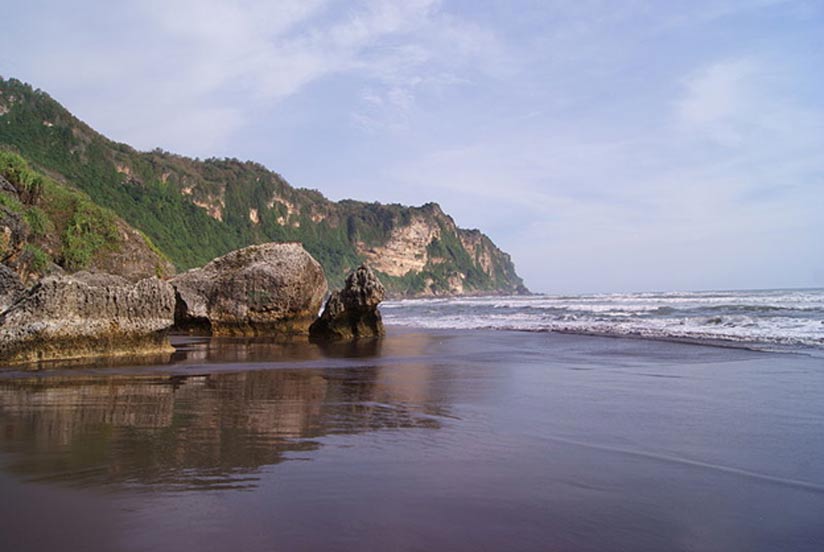
Parangtritis Beach, Yogyakarta, Indonesia, domain of the water diety, Kanjeng Ratu Kidul. (CC BY 3.0)
Featured image: Deriv; Kanjeng Ratu Kidul, the Queen of the Southern Sea of Java. (CC BY-SA 3.0)
References
Brakel, C., “”Sandhang-pangan” for the Goddess: Offerings to Sang Hyang Bathari Durga and Nyai Lara Kidul”, Asian Folklore Studies, Vol. 56, No. 2 (1997), 253-283
Florida, K., “The Badhaya Katawang: A Translation of the Song of Kangjeng Ratu Kidul”, Indonesia, No. 53 (Apr., 1992), pp. 20-32
Jordaan, R.E., “Tārā and Nyai Lara Kidul: Images of the Divine Feminine in Java”, Asian Folklore Studies, Vol. 56, No. 2 (1997), 285-312
Legenda Nyai Roro Kidul Versi Sunda, http://www.nyairorokidul.com/legenda-nyai-roro-kidul-versi-sunda/, accessed 22/02/2016
Ras, J.J., “The Genesis of the Babad Tanah Jawi: Origin and Function of the Javanese Court Chronicle”, Bijdragen tot de Taal-, Land- en Volkenkunde, Deel 143, 2/3de Afl. (1987), pp. 343-356
Room 308, http://www.jawakidul.nl/room308.htm, accessed 22/02/2016
Siapakah sebenarnya Nyai Roro Kidul, http://historia.id/kuno/siapakah-sebenarnya-nyai-roro-kidul, accessed 22/02/2016
The Mystery of Java’s Spirit Queen, http://www.api.sg/main/index.php?option=com_content&view=article&catid=57:special-articles&id=36:the-mystery-of-javas-spirit-queen, accessed 22/02/2016
Wessing, R., “A Princess from Sunda: Some Aspects of Nyai Roro Kidul”, Asian Folklore Studies, Volume 56, (1997), pp.317-353
Wessing, R., “Homo Narrans in East Java: Regional Myths and Local Concerns”, Asian Folklore Studies, Vol. 65, No. 1 (2006), pp.45-68
Wessing, R., “Spirits of the Earth and Spirits of the Water: Chthonic Forces in the Mountains of West Java”, Asian Folklore Studies, Vol. 47, No. 1 (1988), pp. 43-61